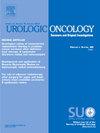在一线铂基化疗后无进展的晚期尿路上皮癌患者中,早期使用avelumab切换维持治疗。
IF 2.3
3区 医学
Q3 ONCOLOGY
Urologic Oncology-seminars and Original Investigations
Pub Date : 2025-07-17
DOI:10.1016/j.urolonc.2025.05.014
引用次数: 0
摘要
背景:局部晚期/转移性尿路上皮癌(la/mUC)患者的标准治疗选择是一线铂基化疗(1L PBC),然后在无进展的患者中使用avelumab 1L切换维持(1LM)。本研究旨在评估在美国接受1L PBC治疗的la/mUC患者的实际治疗模式和结果,并描述在2020年6月FDA批准后早期采用avelumab 1LM的情况。方法:本回顾性队列研究使用Flatiron health数据库的电子健康记录,确定2017年1月至2021年9月期间诊断为la/mUC的成年人。患者根据对1L PBC的实际反应进行分组:完全或部分缓解(rwCR/PR)或疾病稳定(rwSD)。描述了基线特征和治疗模式。临床结果,包括真实世界总生存期(rwOS)和无进展生存期(rwPFS),使用Kaplan-Meier方法进行分析。结果:在1,703例经1L PBC治疗的la/mUC患者中,1245例(73%)患者在研究期间有可获得的缓解数据,其中998例(80%)患者的最佳缓解为rwCR/PR(60%)或rwSD(20%)。rwCR/PR和rwSD患者的人口学和临床特征相似。与rwSD患者相比,rwCR/PR患者从1L PBC开始的中位rwOS和rwPFS更长。在FDA于2020年6月30日批准avelumab 1LM后评估的患者中,有435名患者停用了1L PBC。在这些患者中,339例有缓解数据,138例无进展的患者被认为是符合avelumab 1LM的。其中,97例(70%)患者在最后一次给药1L PBC后180天内开始使用avelumab 1LM,其中40例患者接受二线(2L)治疗,最常见的是强制使用vedotin(60%)。结论:在fda批准后的时期,在1L PBC后的rwSD或rwCR/PR患者中,avelumab 1LM的摄取率很高(70%),其中41%的患者接受了2L治疗,最常见的是使用enfortumab vedotin。本文章由计算机程序翻译,如有差异,请以英文原文为准。
Early real-world utilization of avelumab switch maintenance among patients with advanced urothelial carcinoma without progression following treatment with first-line platinum-based chemotherapy
Background
A standard treatment option for patients with locally advanced/metastatic urothelial carcinoma (la/mUC) is first-line platinum-based chemotherapy (1L PBC) followed by avelumab 1L switch maintenance (1LM) in patients without progression. This study aimed to evaluate the real-world treatment patterns and outcomes in patients with la/mUC in the US treated with 1L PBC and characterize the early adoption of avelumab 1LM following FDA approval in June 2020.
Methods
This retrospective cohort study identified adults diagnosed with la/mUC between January 2017 and September 2021 using electronic health records from the Flatiron Health database. Patients were grouped based on real-world response to 1L PBC: complete or partial response (rwCR/PR) or stable disease (rwSD). Baseline characteristics and treatment patterns were described. Clinical outcomes, including real-world overall survival (rwOS) and progression-free survival (rwPFS), were analyzed using the Kaplan-Meier method.
Results
Of 1,703 identified patients with la/mUC treated with 1L PBC, 1,245 (73%) had response data available during the study period, with 998 (80%) having a best response of rwCR/PR (60%) or rwSD (20%). Demographic and clinical characteristics were similar between patients with rwCR/PR and rwSD. Patients with rwCR/PR had longer median rwOS and rwPFS from 1L PBC initiation vs patients with rwSD. Of patients evaluated after FDA approval of avelumab 1LM on June 30, 2020, 435 discontinued 1L PBC. Of these patients, 339 had response data, and 138 of those without progression were considered avelumab 1LM eligible. Of these, 97 (70%) initiated avelumab 1LM within 180 days following last administration of 1L PBC, with 40 patients receiving second-line (2L) treatment, most commonly enfortumab vedotin (60%).
Conclusion
In the post–FDA approval period, uptake of avelumab 1LM was high (70%) in patients with rwSD or rwCR/PR following 1L PBC, and 41% of these patients received 2L treatment, most commonly with enfortumab vedotin.
求助全文
通过发布文献求助,成功后即可免费获取论文全文。
去求助
来源期刊
CiteScore
4.80
自引率
3.70%
发文量
297
审稿时长
7.6 weeks
期刊介绍:
Urologic Oncology: Seminars and Original Investigations is the official journal of the Society of Urologic Oncology. The journal publishes practical, timely, and relevant clinical and basic science research articles which address any aspect of urologic oncology. Each issue comprises original research, news and topics, survey articles providing short commentaries on other important articles in the urologic oncology literature, and reviews including an in-depth Seminar examining a specific clinical dilemma. The journal periodically publishes supplement issues devoted to areas of current interest to the urologic oncology community. Articles published are of interest to researchers and the clinicians involved in the practice of urologic oncology including urologists, oncologists, and radiologists.

 求助内容:
求助内容: 应助结果提醒方式:
应助结果提醒方式:


